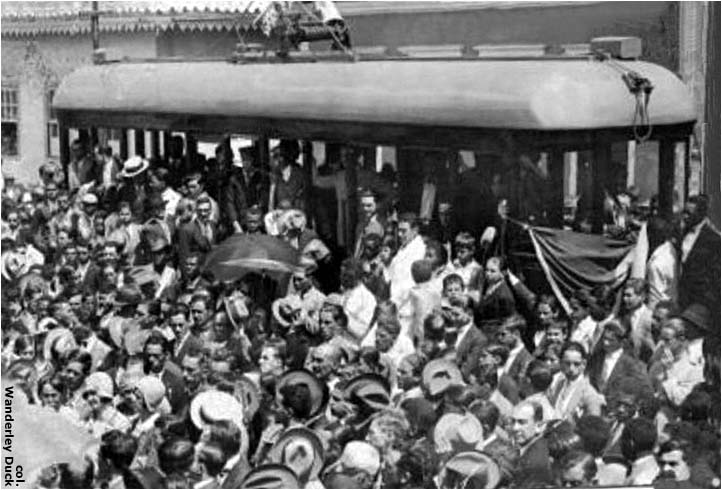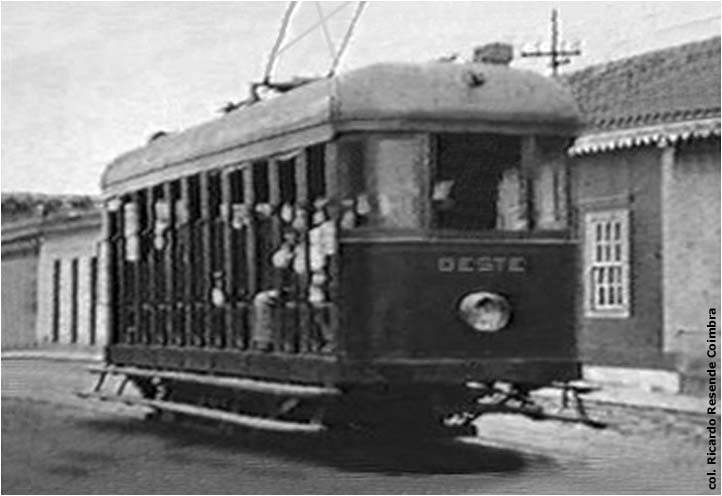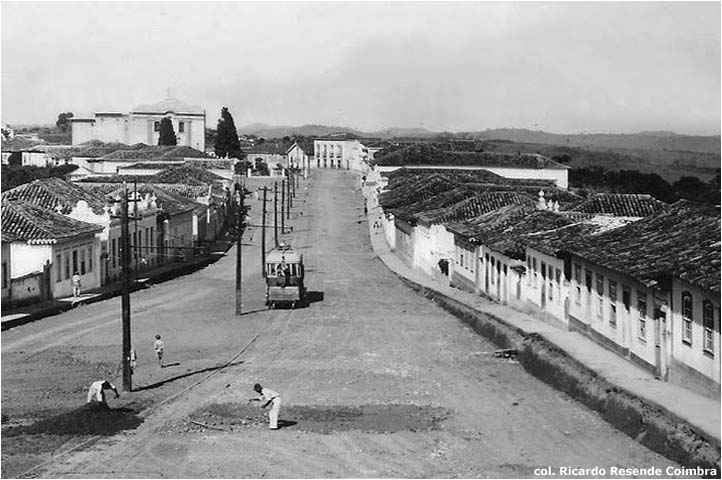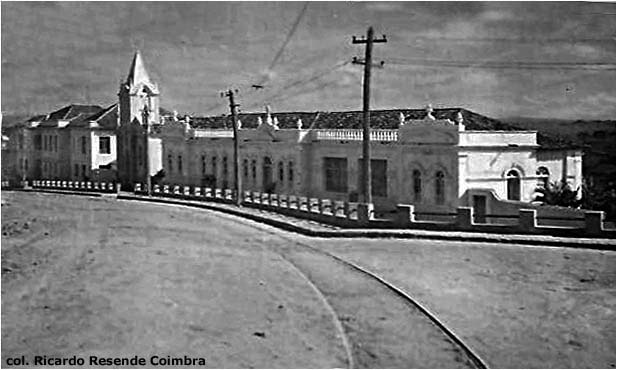The One-Car Tramway in
BOM SUCESSO
Minas Gerais state
BRAZIL
BY
Allen Morrison
Bom Sucesso (named for its patron saint, Nossa Senhora do Bom Sucesso) is a small town about 30 km northeast of Lavras and 180 km southwest of Belo Horizonte. It was not accessible by paved automobile road until the 1950s and was one of the smallest towns in the Americas to have an electric tramway. The line was also one of the few in the world to use only one car. And the tram was home-made. (Most companies owned at least two vehicles in order to have a spare. The electric tramways in nearby Lavras and Sacramento each had two cars, all imported from Germany.) Bom Sucesso's population was about 2,000 in 1900, about 5,000 in 1950, and is only about 15,000 today. The Estrada de Ferro Oeste de Minas extended its 30 in/762 mm gauge line from Aureliano Mourão to Bom Sucesso in 1887 [see map]. The railroad was rebuilt with meter gauge in 1965 and passenger service ended in 1977. The photograph below shows the abandoned railroad station in 2010 [Bruno Carvalho Leal]:
The group hired to install electricity in Bom Sucesso considered a tramway from the station to the town in 1918 [see article]. It did not build one, but it electrified several factories and installed the city's first electric street lights in 1921. It was the EFOM, the steam railroad company that had built an electric tramway in Lavras in 1911, that finally built the electric line in Bom Sucesso. The photograph below, taken 80 years before the photograph above, shows the inauguration of the tramway on 21 September 1930 [see news item in Brazil-Ferro-Carril]. This was the last electric tramway built in Brazil (until after World War 2). Note the 762 mm gauge of the steam railway track and the meter gauge of the electric line [col. Wanderley Duck]:
Celebrants no doubt included the mayor and his family and officials of the EFOM. The motorman and a corner of the tram are visible upper right [col. Ricardo Resende Coimbra]:
Some of the men in the following photograph might be the engineers who built the line. The boys in the foreground and the baby upper left might still be alive today. One wonders what happened to the photographs taken by the man lower right [col. Ricardo Resende Coimbra]:
Bom Sucesso residents gathered to celebrate the tram's arrival in the town [see map]. Some brought umbrellas and parasols for protection from the hot sun [col. Ricardo Resende Coimbra]:
Detail of the photograph above [col. Wanderley Duck]:
The Bom Sucesso tramway, like the line in Lavras, was 3 km long and used meter gauge, but otherwise was quite different: it crossed the Pirapetinga River on its own trestle and climbed the hill, not on a street, but on winding private right-of-way [see map]. And for its Bom Sucesso line, instead of importing equipment from Germany, EFOM claims to have built a tram in its shops. It had ten reversible cross benches, just like the trams in Belo Horizonte [col. Wanderley Duck]:
The vehicle bore a strong resemblance to a model used at that time in Belo Horizonte, which was probably built by Trajano de Medeiros & Cia. in Rio de Janeiro (see photographs). Bom Sucesso could have acquired a tram from the Belo Horizonte system, which used the same meter track gauge, or it could have purchased a vehicle directly from TdeM. "OESTE" identified the owner-operator Estrada de Ferro Oeste de Minas [col. Ricardo Resende Coimbra]:
The EFOM merged in January 1931 with another railroad to form the Rede Mineira de Viação ("RMV"), which presumably operated the tramway from then on. The undated photograph below shows a car in service pushing a cartful of dirt [col. AM]:
Here is the full view, looking southwest. The tram is outbound from the railway station, proceeding north past the Igreja Matriz de Nossa Senhora do Bom Sucesso [see map]. The church faces north [col. AM]:
The same view southwest down the principal street, but taken from a point closer to the end of the line [see map]. Note the same two trees in front of the church. The tram is still pushing the cart up the hill, perhaps bringing dirt to the workmen in the foreground, who have blocked the track [col. Ricardo Resende Coimbra]:
This recent airplane view of the church reveals the addition of twin towers. It's the same church, in the same place [Prefeitura Municipal de Bom Sucesso]:
Coming from the railway station in the valley, one approaches the church from the back [see map]. This is an early view, taken before the streets were paved for automobiles [col. Wanderley Duck]:
A view south, from the back of the church. This is the point where the tramway turned off the main street and onto its "reserved track" for its trip down the hill to the railway station [see map] [col. Ricardo Resende Coimbra]:
The precise location of the scene below is unknown, but this structure must be somewhere on the winding route down the hill [see map]. Part of the tramway may have been pathed in later years [col. Ricardo Resende Coimbra]:
The photograph below seems to have been taken in the 1940s and, except for the color views, may be the most recent image on this page. This is probably the eastern end of the main street [see map] [col. Ricardo Resende Coimbra]:
Since the tramway had only one car, its garage was a simple affair. This is the far eastern end of the line [from the "Bom Sucesso" chapter in vol. XXIV of the Enciclopédia dos Municípios Brasileiros (Rio de Janeiro, 1958)]:
The Bom Sucesso tramway had a short life. The annual transport reports of the Instituto Brasileiro de Geografia e Estatística last mention the Bom Sucesso tramway in the survey dated 31-XII-1947. The latter reports only two employees (!) and the line is not mentioned at all in later reports. If the data are accurate, the Bom Sucesso tramway closed sometime in 1947 – perhaps on the last day of that year. Mayor Aurélio Ferreira Guimarães, who assumed office in 1948, initiated a street-paving program and removed the tracks. Legend holds that the vehicle remained in its little barn until the late 1960s when Mayor Geraldo Luís de Resende sold it for scrap. Here is a nice view of the town in 2007, looking – as always – toward Nossa Senhora do Bom Sucesso [Cure Byte]:
BIBLIOGRAPHY Instituto Brasileiro de Geografia e Estatística. Anuário estatístico do Brasil, 1930-. Rio de Janeiro, 1936-. The tramway statistics published erratically in the "Meios de Transporte" section are incomplete. Data for the Bom Sucesso operation are supplied only for the years 1945, 1946 and 1947. The 1947 chart is reproduced here. Venâncio Castanheira Filho. História de Bom Sucesso. 267 pages, Bom Sucesso, 1973. The "Bonde" chapter on pp. 141-142 briefly describes the operation. Linked here. Ralph Mennucci Giesbrecht. Estações Ferroviárias do Brasil. The Bom Sucesso page provides rare and valuable information about the station and the railways that it served. Five photographs.
The author would like to express his gratitude to Senhores Antonio Miranda, Walter Castanheira, Wanderley Duck, Ricardo Resende Coimbra and Ralph Mennucci Giesbrecht for the information and invaluable assistance that they provided for the preparation of this page.
See also The Tramways of Belo Horizonte and my index of If you have comments, criticism or suggestions, This site was placed online on 23 June 2012; Copyright © 2012-2112 Allen Morrison |

















